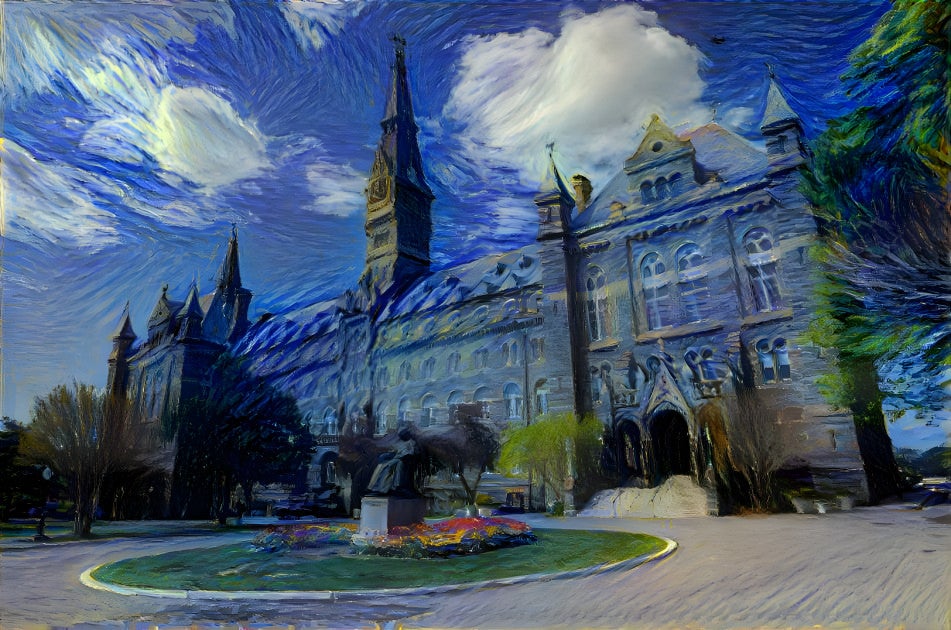Can Artificial Intelligence be Creative?
Posted in 2022 Recent Blog Posts The Gnovis Blog | Tagged AI, Art, artificial intelligence, creativity
More than 2000 years ago, Plato made several interesting references to the notion of creativity, in the Socratic dialogues. In Meno, Socrates claims that “when poets produce truly great poetry, they do it not through knowledge or mastery, but rather by being divinely “inspired” by the Muses”. In another dialogue, Socrates contemplates the origins of new knowledge, which can be interpreted as creative thinking. Socrates wondered how can existing knowledge evolve into new ideas. When asked by Meno, “will we say, of a painter, that he makes something?”, Socrates responded, “no, he merely imitates”.
AI can be very good at imitating and learning from the creative works of humans. The below painting of the Healy Hall at Georgetown University, was produced by the Deep Dream Generator, an AI project sponsored by Google. I put in an image of Healy Hall, chose the “Starry Night” painting of Van Gogh as an overlay, and the program put out this painting within a minute. I find it aesthetically pleasing, but I understand it is not a completely original work. Nonetheless, do not all students of art learn by imitation? Can Artificial Intelligence learn to be truly creative?

“Creative souls and glory seem,
Submissive and subtle and soft and serene.”
These two lines were produced by another Google project AI poem generator when I put in my keyword, creativity. The algorithm has learned to write poems “by reading over 25 million words written by the 19th-century poets.” Compare that to the below poem written by Lord Byron in 1816 during the First Industrial revolution.
“As the Liberty lads o’er the sea
Bought their freedom, and cheaply, with blood,
So we, boys, we
Will die fighting, or live free,
And down with all kings but King Ludd!”
– Lord Byron, 1816
Creativity is a challenging concept to define, but it is not difficult to recognize. Clearly, on a creativity scale, AI falls far behind Byron. By the way, Byron was not a Luddite but had sympathies for their cause. (Luddites were a radical anti-technology movement in 19th century England.) Interestingly, Lord Byron is also the father of Ada Lovelace, who is often described as the world’s first computer programmer. Lovelace is credited for creating the first algorithm that was put to use in her friend Charles Babbage’s Analytical Engines. Lovelace also proposed that “until a machine can originate an idea that it wasn’t designed to, it can’t be considered intelligent in the same way humans are.”
In 2001, this approach inspired a group of engineers led by Selmer Bringsjord to come up with the Lovelace test, which many computer scientists consider a better replacement for the outdated Turing test. A computer can pass the Lovelace test only if it produces an outcome it was not programmed to. For example, a novel idea or an original painting. However, there is one more condition of the Lovelace test: the software output should surprise the human designer of the program. She should not be able to tell how the program achieved that outcome.
To this day, it is an open question whether any AI can pass the Lovelace test. In 1997, World Chess Champion Garry Kasparov (originally from my hometown Baku) lost to chess-playing supercomputer Deep Blue. Many people believe that mastering chess is associated with creative thinking. Deep Blue was calculating between 100 and 200 million positions on a 64-square chessboard, but it was following grammatical boundaries prescribed by its designers. The scientists behind Deep Blue at Carnegie Mellon University cannot beat the world champion in chess, but their brainchild can. Deep Blue’s victory over Kasparov marked a major milestone in the development of AI, but it did not prove that AI can be creative.
Maybe the challenge is that creativity belongs in the arts domain, and we are trying to explain it scientifically. Albert Einstein famously said “It would be possible to describe everything scientifically, but it would make no sense. It would be a description without meaning—as if you described a Beethoven symphony as a variation of wave pressure.” The founder of psychoanalysis, Sigmund Freud believed that pain and repression are necessary ingredients for creativity. Does this mean we will have to teach AI to experience pain, so it can be creative?
Humans have been creative since the beginning of days, but across the globe, ancient cultures did not have a word to express creativity. The modern notion of human creativity emerged only in the age of Enlightenment in Europe, and it became a popular catchfrase during the 20th century. People applied it to the course of history and identified it as one of the driving forces behind our evolution. Various studies have demonstrated that even some animals have creative potential, but none of them can be a rival to human creativity. Now, recent breakthroughs in technology have inspired many ideas about the prospective of machines to compete with human creativity. However, there is no conclusive answer due to two reasons: there is no clear philosophical definition of creativity and AI is rapidly evolving.
References
Devlin, E. (2019, May 2). Create a personalized poem, with the help
of AI. Google. https://www.blog.google/outreach-initiatives/arts-culture/poemportraits/
Kaufman, S. B. (2014, May 12). The Philosophy of Creativity.
Scientific American Blog Network.
https://blogs.scientificamerican.com/beautiful-minds/the-philosophy-of-creativity/
Miller, A. I. (2020, February 1). Machines have learned how to be
creative. What does that mean for art? Salon.
https://www.salon.com/2020/02/01/machines-have-learned-how-to-be-creative-what-does-that-mean-for-art/
Pearson, J. (2014, July 8). Forget Turing, the Lovelace Test Has a
Better Shot at Spotting AI. Vice.
https://www.vice.com/en/article/pgaany/forget-turing-the-lovelace-test-has-a-better-shot-at-spotting-ai
Plato. The Republic. (1998). The Project Gutenberg.
https://www.gutenberg.org/files/1497/1497-h/1497-h.htm
